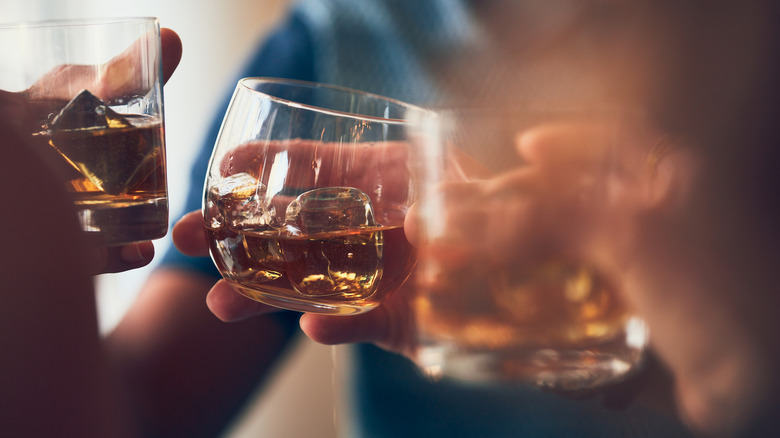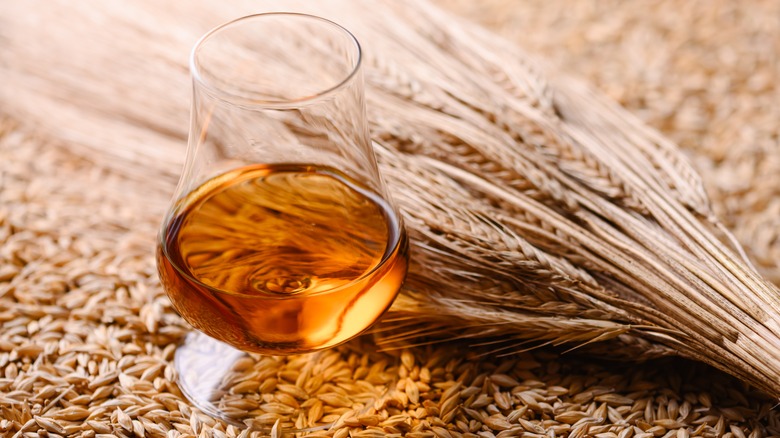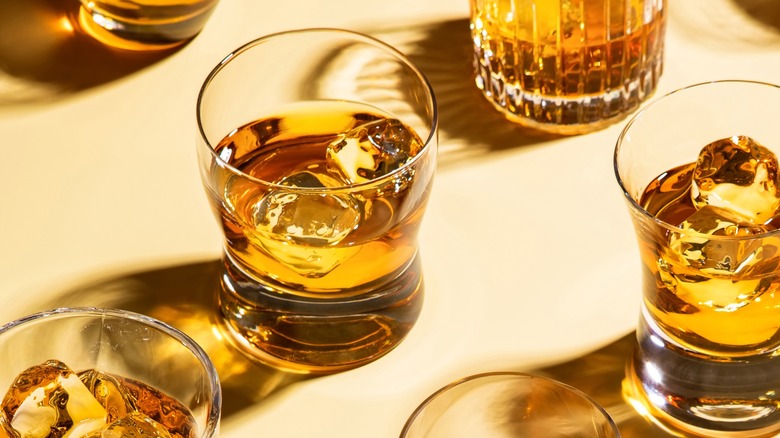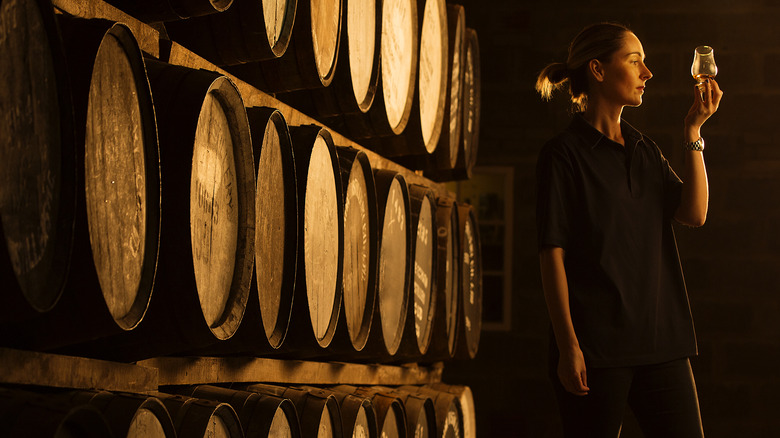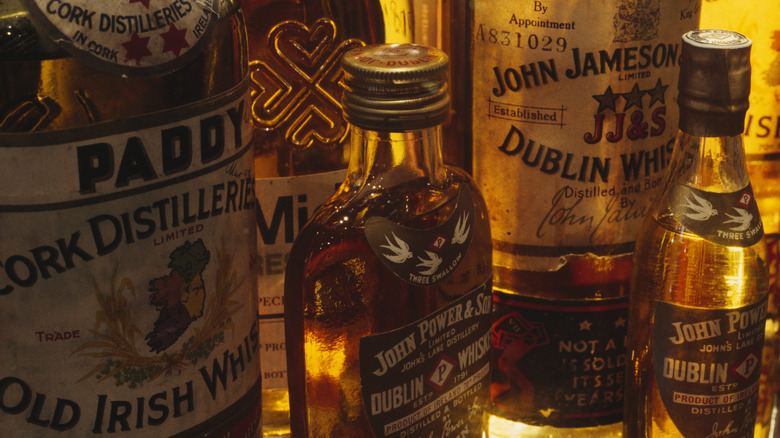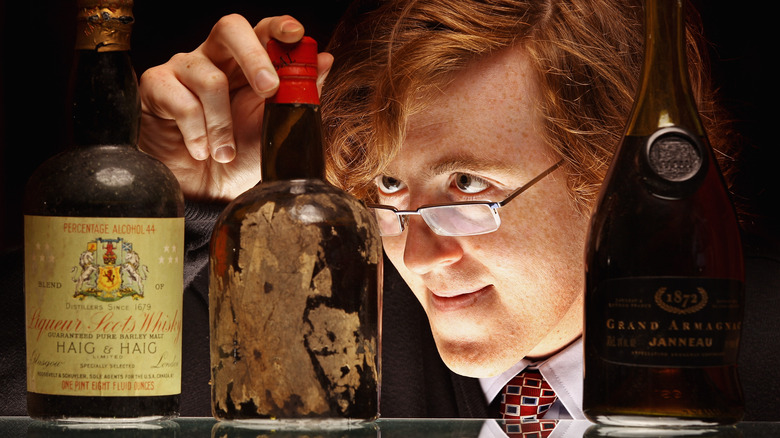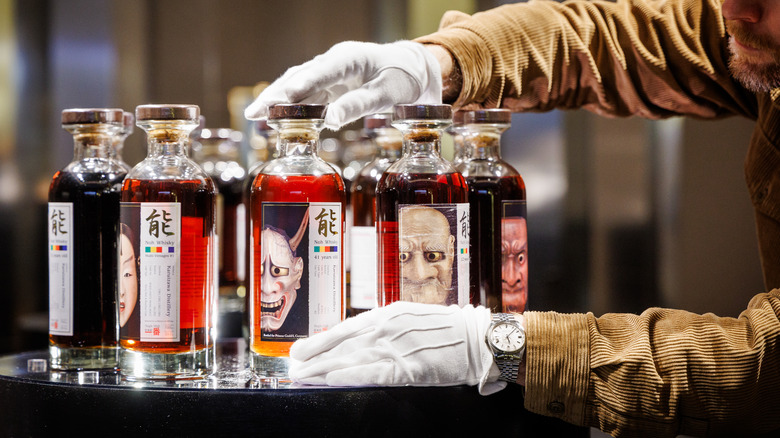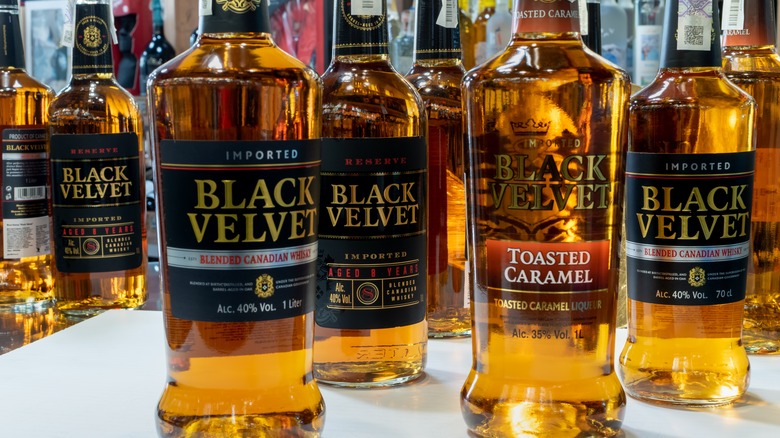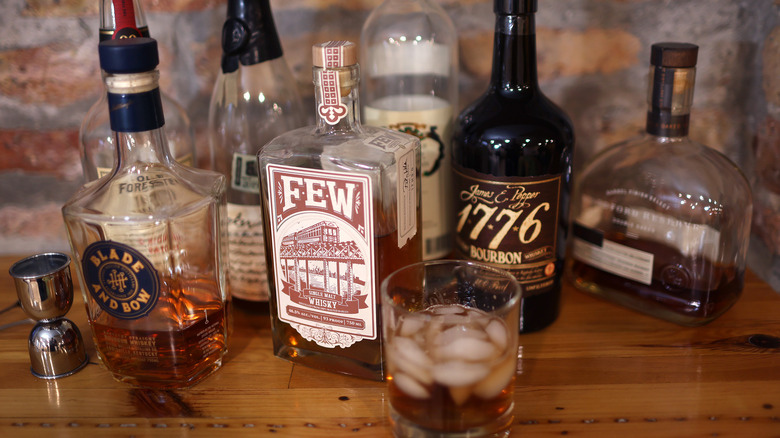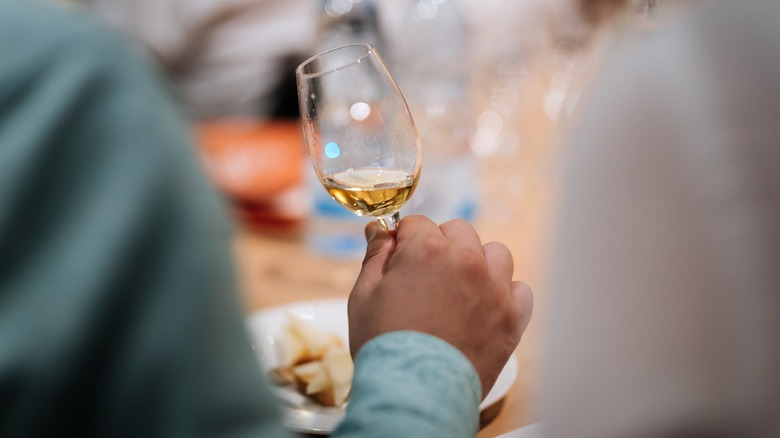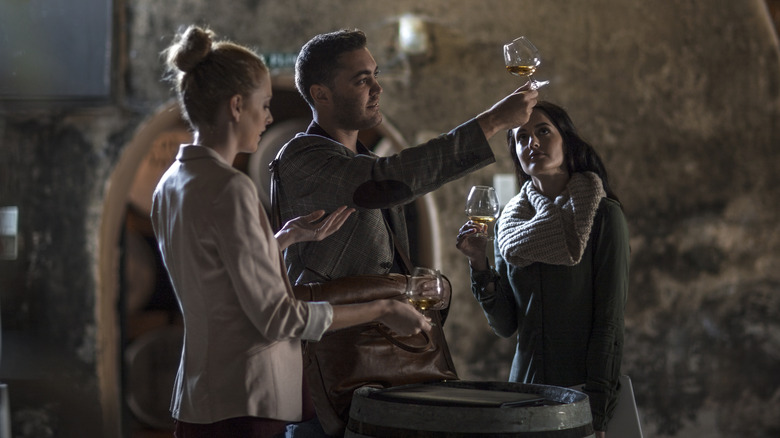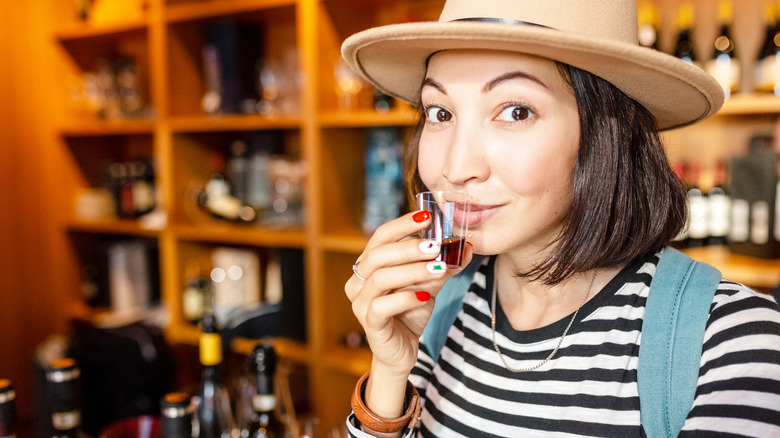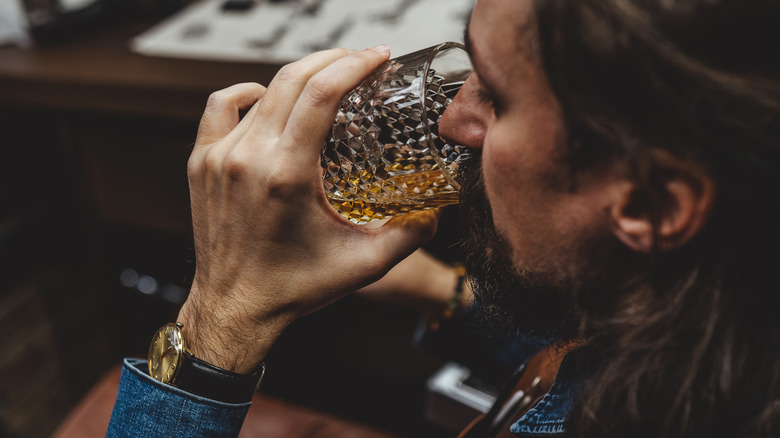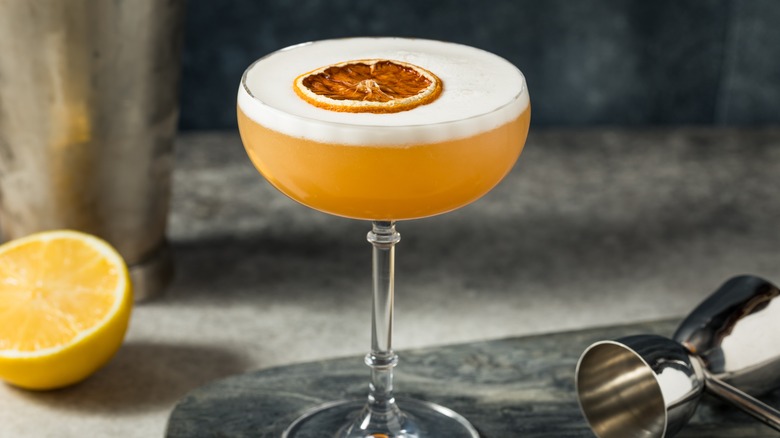Several Whiskeys (And Whiskies), Explained By Distillers And Mixologists
We may receive a commission on purchases made from links.
If you're picturing an ice-cold, bourbon porch pounder guzzled from a red plastic cup, or a 25 year single malt scotch sipped neat to smooth jazz ... you're picturing whiskey right? (Wait — or, is it whisky?) Lucky you, we tapped a few pros to float the details on the spirit powering a $69 billion global industry.
Our expert panel starts out like this: A pitmaster, a bartender, and a couple distillers walk into a bar. But, instead of a punchline, they're offering us real whiskey wisdom you can tuck in your back pocket. Nashville's Peg Leg Porker owner and pitmaster Carey Bringle fires up the smoker along with the "World's Best Bourbon" from Peg Leg Porker Spirits; former Los Angeles mixologist and cocktail program designer Alisa Berhorst of Tom's Oyster Bar slings drinks and enlightening perspective; and TX Whiskey head distiller Evan Brewer as well as head blender Craig Blair of TX Whiskey bottle insight that goes down smooth as a Rusty Nail. (It's a cocktail — and it's delicious).
Japanese to Irish, single malt to blended, and whiskey to ... um, whisky-without-the-E, we're setting 'em up and knocking 'em back to bring you everything you need to know about this smoky, sweet, malty, earthy, peaty, spicy spirit. Grab a proper rocks glass and pour yourself a taste of the whiskey life.
So what makes whiskey ... whiskey?
What the heck do we even mean when we talk about whiskey? From cinnamon Fireball shots to the Macallan 1926 single malt that went for $1.9 million at Sotheby's — everything seems to fall under this boozy umbrella. So what defines a whiskey?
"Whisk(e)y is a broad category that, at its core, is a spirit distilled from a fermented mash of grain," explains Evan Brewer, head distiller at TX Whiskey. "Different countries/unions have differing definitions and styles such as the size and type of barrel that can be used or the proof [at which] the spirit can be distilled." Offering some guidance on where whiskey's signature flavor characteristics come from — and, yeah, there are many variations on the theme — Carey Bringle, Peg Leg Porker owner and pitmaster, clarifies that whiskey is "typically made from barley, corn, rye, or wheat. Whiskey has a rich and complex flavor profile, and depending on the variety and the aging process, it may have notes of smoke, oak, vanilla, or caramel."
After nearly three decades spent studying bleary-eyed whiskey fans from behind the bar, Alisa Berhorst describes the cultural effect of this spirit, sharing, "It's a drink that has the power to bring people together, to slow things down, and to spark conversation ... I've seen complete strangers bond over a shared bottle of whiskey, or customers revisit old memories as they sip their favorite brand."
Hold on -- Why is whiskey spelled two different ways?
So is it whiskey or whisky? Let the official spelling bee record state that whiskey is spelled W-H-I-S-K-E-Y — or — W-H-I-S-K-Y. It's the same thing, just from different places. (And it seems totally confusing until you understand the method to the madness.) "There is no difference between 'whiskey' and 'whisky' except for the spelling and where it's made," says Carey Bringle, Peg Leg Porker owner and pitmaster.
Want a little trick to keep it straight? Evan Brewer, TX Whiskey, has your back. "A good rule of thumb is that whiskEy is used in AmErica and IrEland while whisky is used in other countries like Scotland, Canada, and Japan," he shares. But he's also pretty relaxed about the etymology baffling even the most devoted fans of this sippable spirit. (PhEw.) "In the end, I say: Spell it how you like as long as you're enjoying it."
Why is whiskey kept in barrels?
Obviously the point of whiskey barrels is to act as your clothes in case you time-travel to a 1900s cartoon and forget a change of underwear. But it seems there are legitimate reasons for why whiskey is kept in barrels, known broadly in the biz as casks.
"There are many ways a cask can influence the flavor, aroma, and overall character of a whiskey," says Craig Blair, head blender at TX Whiskey. The cask category covers a wooden container of any size that's used to age whiskey. It's a method that goes all the way back to the Middle Ages, where Celtic Christian monks once crafted the village booze in oak barrels. This practice created such remarkable spirits, it's still a thing today. As Carey Bringle, Peg Leg Porker owner and pitmaster, describes it, "The type of cask used to age whiskey impacts the flavor of the whiskey. Most whiskey casks are made from either American oak or European oak. American oak has notes of vanilla and caramel, whereas European oak is spicier and has a stronger wood flavor."
"A few important factors include the age and type of wood used, the different charring and toasting processes, the contents that were previously in the cask, and the size of the cask itself," Blair says. Here's hoping that barrel wood was previously used to roast s'mores.
What's so special about Irish whiskey?
Just about every variety goes down like gangbusters after clinking glasses, but only one can claim the title of Irish whiskey. As one Irish toast goes, "May the roof above us never fall in. And may the friends gathered below it never fall out."
"Irish whiskey ... is known for its triple distillation, giving it a smoother, more delicate flavor profile," says Alisa Berhorst, former Los Angeles mixologist and cocktail program designer at Tom's Oyster Bar. "Working in the bar scene in L.A., I've found that European whiskies often attract ... those who appreciate a more traditional approach, with history and terroir playing a key role in the glass." The triple distillation process — part three of which is designed to bolster the strength of the alcohol and deepen flavors like pear, lemon, or apple — has been an Irish tradition since before you were born. "Irish whiskey dates back to the 12th century when religious monks first brought the technique to Ireland and began distilling alcohol," says Carey Bringle, Peg Leg Porker owner. "Single-pot whiskeys were the most common style of Irish whiskey until the emergence of blends in the 20th century." Those single pot still Irish whiskeys are the only category still exclusively crafted in Ireland, where malted and raw barley give this spirit that special spice.
What defines a Scotch whisky?
With a rep for limited-run batches that go bananas at auction, you probably can't think of somebody playing flip cup with, say, a Macallan Lalique 50-Year-Old Single Malt Scotch Whiskey in a tapered Glencairn. But just because it's got a hoity-toity heritage doesn't mean this spirit's out of reach. Alisa Berhorst, former cocktail program designer at Tom's Oyster Bar, says "each region in Scotland offers a distinct style — from the smoky, peaty whiskies of Islay to the smooth, sherry-influenced malts from Speyside."
"Scotch whisky, also known as 'Scotch,' is made exclusively in Scotland and has strict regulations to ensure its quality, authenticity, and integrity," explains Carey Bringle, owner of Peg Leg Porker. "It's typically distilled twice, compared to the triple-distilled process in Ireland, and must be aged for at least three years in oak barrels." This time it was Friar John Cor (not the monks) who came up with the idea to get smashed in Scotland in 1494, with doctors later prescribing whisky as medicine (cough, cough) to get around prohibition during the 1920s. So what exactly is this Rx? "Scotch often has a smoky or charred note, due to the use of malted barley dried over peat fires," describes Bringle. "The flavor characteristics vary depending on the region and the individual ingredients used by distillers." Single malts get all the glory, but blended Scotch whiskies offer affordable entry into the cool kid's club.
What makes Japanese whisky so good?
Some people say it's more "refined" than — or the "gateway" to — Scotch whisky. But you can almost see this heritage before you ever taste it: Japanese whisky — no E (just like the scotch kind). So how are these two industry titans related?
"Japanese whisky was inspired by Scotch whisky and is known for its balance, subtlety, and refined flavors," says Peg Leg Porker owner Carey Bringle. "Japanese whisky ... was established in the early 20th century when Masataka Taketsuru traveled to Scotland to learn how to distill 'proper' single-malt whisky." The child of sake makers, Taketsuru innovated Suntory's Yamazaki Distillery, later launching his own rival company, Nikka Whisky, in the 1940s. "Like scotch, Japanese whisky is made with barley and smoked with peat but is tweaked to suit the country's taste," Bringle adds. "Many Japanese whiskies are matured [in] casks made from mizunara oak, lending notes of fruits and spices." Just how old is Japanese mizunara oak when it's ready for production? A cool two centuries ... ish. No wonder this rare tree can fetch $6,000 per cask.
Speaking on the popularity of this relative newcomer to the scene, Alisa Berhorst, former Los Angeles mixologist at Tom's Oyster Bar, notes the aesthetic powering this precision-made spirit. "Japanese whiskey feels like a reflection of its culture — respect for tradition paired with a forward-thinking approach," she shares. "I've seen whiskey drinkers, particularly those looking for something new and refined, gravitate toward Japanese bottles." Without protected geographical indication, you'll find Japanese-inspired whisky brands popping up in the United States.
What is the flavor profile of Canadian whisky?
Not relegating itself to being America's top hat, Canada's whisky bench goes deeper than your purple velvet-ensconced bottle royale. But with its sometimes-maligned allowance for up to 9.09% volume of added flavors, colors — or even additional spirits — Canadian whisky is often considered an excellent starting point for newbies. "Canadian whiskies are often a gateway for those just beginning their whiskey journey," says Alisa Berhorst, whiskey expert and former cocktail program designer at Tom's Oyster Bar. "Known for its lighter, smoother character, it's ... highly versatile in cocktails." (It's as if she poured us our first Salted Caramel White Russian.)
Legitimate standards guide an industry that's been around since before Canada became a thing in 1867. "Canadian whisky has a unique profile and distinct regulations," explains Carey Bringle, Peg Leg Porker owner. "It must be mashed, distilled, and aged in Canada; aged in small wooden barrels for a minimum of three years; and must contain a minimum of 40% alcohol by volume. One of its defining traits is the ability to blend different grains into a single whisky, which allows for a wide range of flavors and styles." While single malt Canadian whisky is indeed on the rise, the more common blended variety really makes you thirsty for a Canadian whisky apple cocktail, eh?
Which whiskey is made in the U.S.A.?
"American whiskeys are a favorite for both the seasoned whiskey connoisseur and newcomers looking to explore something with character," says whiskey pro Alisa Berhorst.
Every American whiskey starts with a fermented mash bill that delineates grain ratios needed for each particular spirit. "Most American whiskeys are distilled below 160 proof and aged in new charred oak barrels," explains Evan Brewer, TX Whiskey head distiller. "This means that American whiskeys are typically bolder with a bit more smoke and oak from the barrel, and more of the flavors from the grain and fermentation are present."
Offering the top-billed category rundown, Carey Bringle, Peg Leg Porker, explains, "American whiskey encompasses several styles, with bourbon, rye, and Tennessee whiskey being the most popular." (Former U.S. president, Ulysses S. Grant, loved Old Crow bourbon — clearly vibing on notes of vanilla, oak, caramel, and candy corn.) "Bourbon is aged in charred, new oak barrels with no restrictions on cask size or aging period," adds Bringle. "Rye must be made with at least 51% rye in the grain mash [and] it's known for its peppery, bold profile, which adds depth to cocktails like an Old Fashioned or Manhattan. Tennessee whiskey is exclusively crafted in Tennessee. It must be charcoal-filtered ... and include at least 51% corn in the grain mash bill." As Brewer also reminds us, "American whiskey as a category is still being defined."
Can whiskey come from anywhere in the world?
Short answer: Heck yeah. Pick a favorite, or step out on a world tour thanks to the whiskey industry's meteoric rise all around the globe. "Each region offers a fresh take on whiskey," says Carey Bringle, owner of Peg Leg Porker. Already booked a ticket to Whiskeytown. (So ... where are we going exactly?)
Israel's first distillery, Milk & Honey, has been producing barrels bursting with a scotch-inspired spirit since 2015. "Israeli whisky is influenced by its desert climate, which creates a faster aging process," explains Bringle. On the other side of the world, New Zealanders cash in on natural resources and scotch brewing technique that goes back to the 1800s. "New Zealand whisky is known for its fruity sweetness," Bringle notes, adding that Scandinavians certainly won't be left out in the cold without a dram in hand, either. "Denmark's cool climate lends [itself] to a smoother and more refined spirit."
But if you've been feeling the Deutschland energy in the United States, that's because Germany's whisky has entered the chat — and the U.S. market. "German whisky, the newest addition to the category, typically comes from small-scale distilleries and is made from malted rye," Bringle continues. "The types of barrels used can vary, ranging from ex-bourbon, ex-sherry, or even local wine casks for aging, adding complex layers of flavor." With 36 countries producing whiskey (or whisky), you can taste the world with a tip of your glass.
What's the difference between single malt and blended?
If your head feels swimmy when you're deciding between single malt versus blended whiskey, you're not alone. Allow us to share a little "whiskey-snob" knowledge — without the eye-rolling flex.
"The main difference between single malt whiskey and blended whiskey lies in their composition and production methods," says Craig Blair, head blender of TX Whiskey. "Single malt whiskey is made from malted barley and produced at a single distillery using pot stills, while a blended whiskey is a combination of different types of whiskey." Noting the drinkability of a mixed bag-style recipe, Peg Leg Porker owner Carey Bringle shares, "Blended whiskey is generally smoother and more balanced. Single malts are more complex and nuanced, showcasing the unique characteristics of the distillery." While single malt whiskeys can range in cost from relatively affordable to jaw-droppingly steep (based on things like being really rare, really ancient, or really precious), price tag-prestige doesn't matter if the flavors aren't your jam. Sip free, friends.
What's the future of the whiskey industry?
It's a centuries-old tradition, but makers gonna innovate. Whether it's about local sourcing, heirloom grains, or reducing emissions in the aging process, whiskey brewing reflects emerging technology and a culture of non-stop creativity. "Sustainability is becoming a focus with distillers working to reduce their environmental impact," says whiskey expert and Peg Leg Porker owner Carey Bringle. "There's also a growing interest in smaller craft distilleries that produce unique, small-batch whiskies with local grains and innovative techniques."
Speaking of those new methods, Craig Blair, head blender at TX Whiskey, agrees that, "The whiskey scene is always evolving." Hailing from a Fort Worth, Texas distillery that lets visitors to the Whiskey Ranch witness operations first-hand, Blair explains, "At [TX Whiskey], we are currently working on sustainable practices with our sole grain provider at Sawyer Farms. We also offer multiple limited edition Experimental Releases throughout the year where we showcase some of these aging and finishing techniques, alongside the cool things we can do in the stillhouse." Those offerings have featured Unaged White Dog whiskey that runs clear as water, and Texas straight bourbon aged in former cabernet barrels. "Keeping an eye on these trends can help you discover new favorites and appreciate the ever-evolving world of whiskey!"
What's the right way to drink whiskey?
Good news: If you're enjoying whiskey, you're doing it right. But who better to recommend a tipple than a few pros as seasoned as the whiskey barrels themselves. So, what does a whiskey industry expert really drink?
"Personally, I like 8-year-old whiskey, which I think is the sweet spot for bourbon," reveals Carey Bringle of Peg Leg Porker. "I drink it on the rocks." (He might be talking about Peg Leg Porker's 8 Year Tennessee Straight Bourbon Whiskey.) Representing new-school craft in the Lone Star State, TX Whiskey's Evan Brewer shares, "I'm biased in preferring our 90-proof bourbon either neat or on the rocks with some water." (You'll find that one here), with Craig Blair, head blender of TX Whiskey, explaining, "I typically lean towards high proof bourbons and really enjoy drinking our TX Barrel Proof neat." (Yep — here you go.) Making converts out of whiskey-hesitant clients, Alisa Berhorst, former Los Angeles mixologist and cocktail program designer at Tom's Oyster Bar, says, "I often reach for bottles like Basil Hayden, Blanton's, or Michter's Small Batch Bourbon." While taking your whiskey neat might best represent a whiskey's flavor, Berhorst has cocktail lovers covered, too ...
The best entry-level whiskey cocktail to shake right now
Her dream dram might be a Pappy Van Winkle, but Alisa Berhorst, former Los Angeles mixologist, has her eye on her bar patrons' palates. "One of my proudest moments was creating a signature whiskey cocktail for Mama Shelter, where the goal was to balance the boldness of bourbon with lighter, citrus-forward ingredients," she recalls. "The result was ... a crowd favorite."
Berhorst recommends a smooth, chest-warmer as a first-time whiskey cocktail: "The Whiskey Sour. It's simple, approachable, and strikes the perfect balance between sweet, sour, and the warmth of whiskey ... The citrus helps smooth out the edges of the whiskey, making it an ideal introduction for new drinkers, while the egg white gives the drink a lovely frothy texture without altering the flavor." We'll drink to that.

